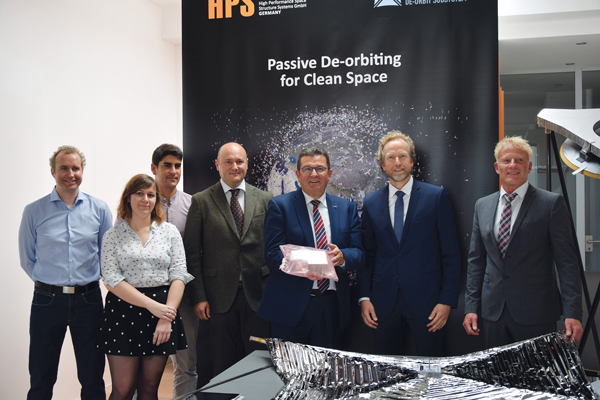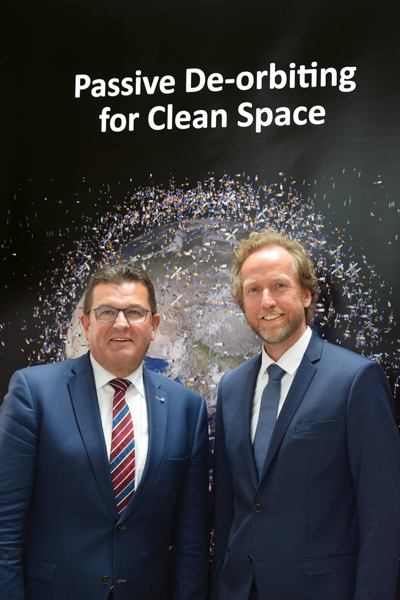September 2022
UNIO will equip all their European constellation satellites with ADEO
UNIO Enterprise GmbH, THE European NEWSpace System house for satellite constellations made in Germany, founded by ISAR Aerospace, Mynaric, Reflex Aerospace and SES S.A has confirmed to equip all their European constellation satellites with the ADEO dragsail module: https://unio.global/.
ADEO will accelerate the decommission of the satellites and prevents space from getting polluted by debris even before it occurs.
We feel honored to have been selected as a partner for space sustainability by this meanwhile famous European NewSpace system house: To us at HPS, this is inspiration and motivation to carry on driving the idea of space sustainability to its technological extremes.
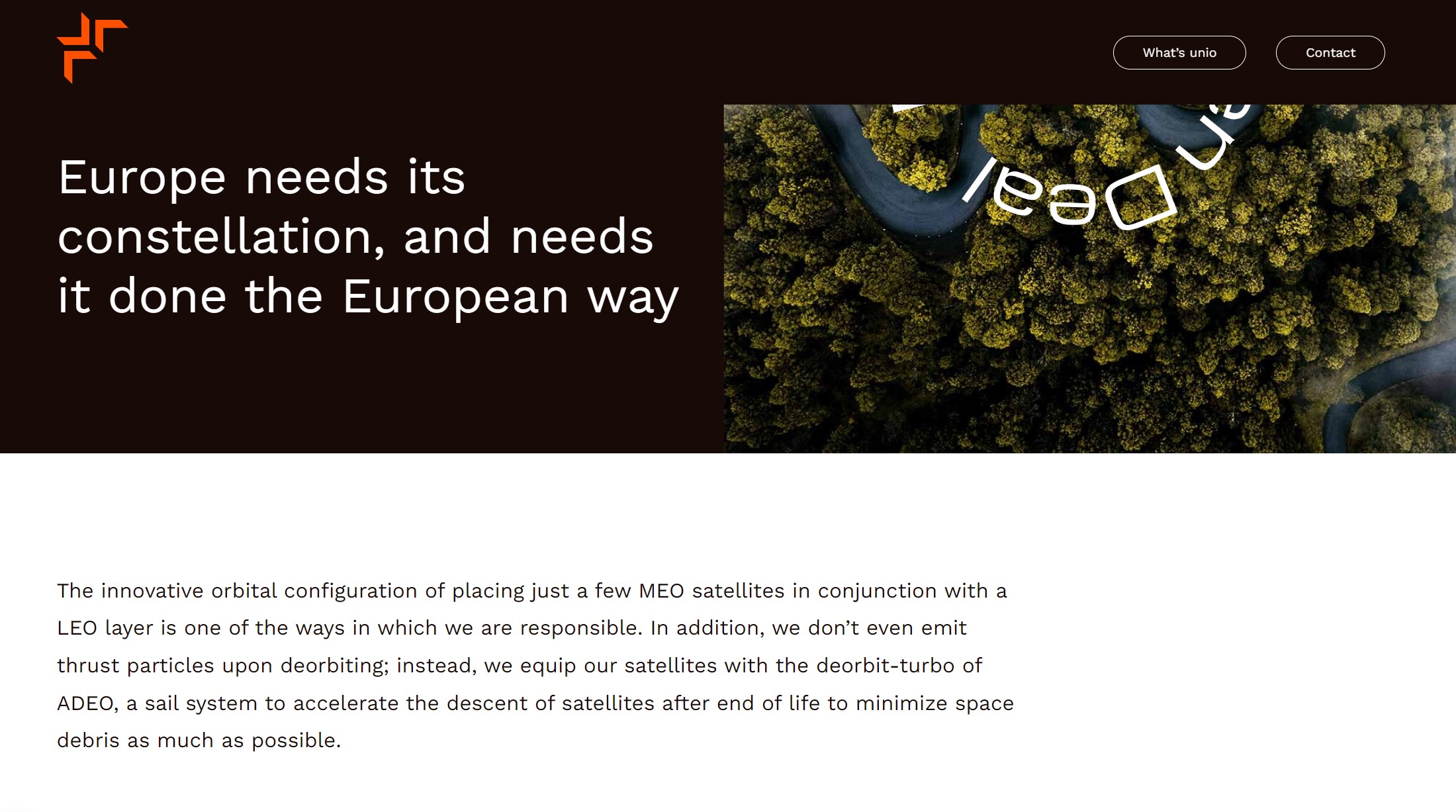
August 2022
ADEO deorbit sail product family continues to grow: Successful financing round for industrialization of ADEO Medium for constellation satellites
Paris-Munich. August 1, 2022.
Just one last signature, and the success story of the almost decade-long development of the European deorbit sail ADEO by HPS is going to find its seamless continuation: the model ADEO M for medium satellites of 100-700 kilo weight on orbits up to 900 km altitude – so, typical representatives of the currently almost exponentially growing constellation projects – will be made fit for series production and distribution on the commercial market by the HPS Group in Germany and Romania.
Parallely, additional features of ADEO N (Nano) will be developed. ADEO M follows the versions ADEO N and ADEO L (Large), which have already been on the market for 1.5 years. With the third model, HPS now closes the last gap in its product portfolio and addresses in particular the booming NewSpace market thanks to maturity level TRL 9 and growing flight heritage on missions of various carriers with world-leading deorbit automatic.
This leadership is also a result of the steady and now renewed support from Europe’s GSTP technology program and its German SME initiative on the part of ESA and DLR Space Agency. “Everyone is talking about space debris; thanks also to ESA´s “Zero Debris Initiative”, with ADEO, our customers are making sure it doesn’t even happen.
This is the only way a clean-green mission works, the only way the EU’s Green Deal becomes a reality also in space.”
For each satellite on LEO there is a suitable ADEO, which accelerates deorbiting by a factor of about 20. All interested companies get the exact forecast free of charge and super fast; all they have to do is feed our globally unique “ADEO deorbit timer” with the data of their satellite and then let the algorithms do their jobs,” says HPS CEO Dr. Ernst K. Pfeiffer. As in the case of ADEO N and ADEO L, already now orders for new satellite projects are also being accepted for ADEO M, shortly before the start of series production, in order to harmonize planning and production processes on both the HPS and the customer sides.
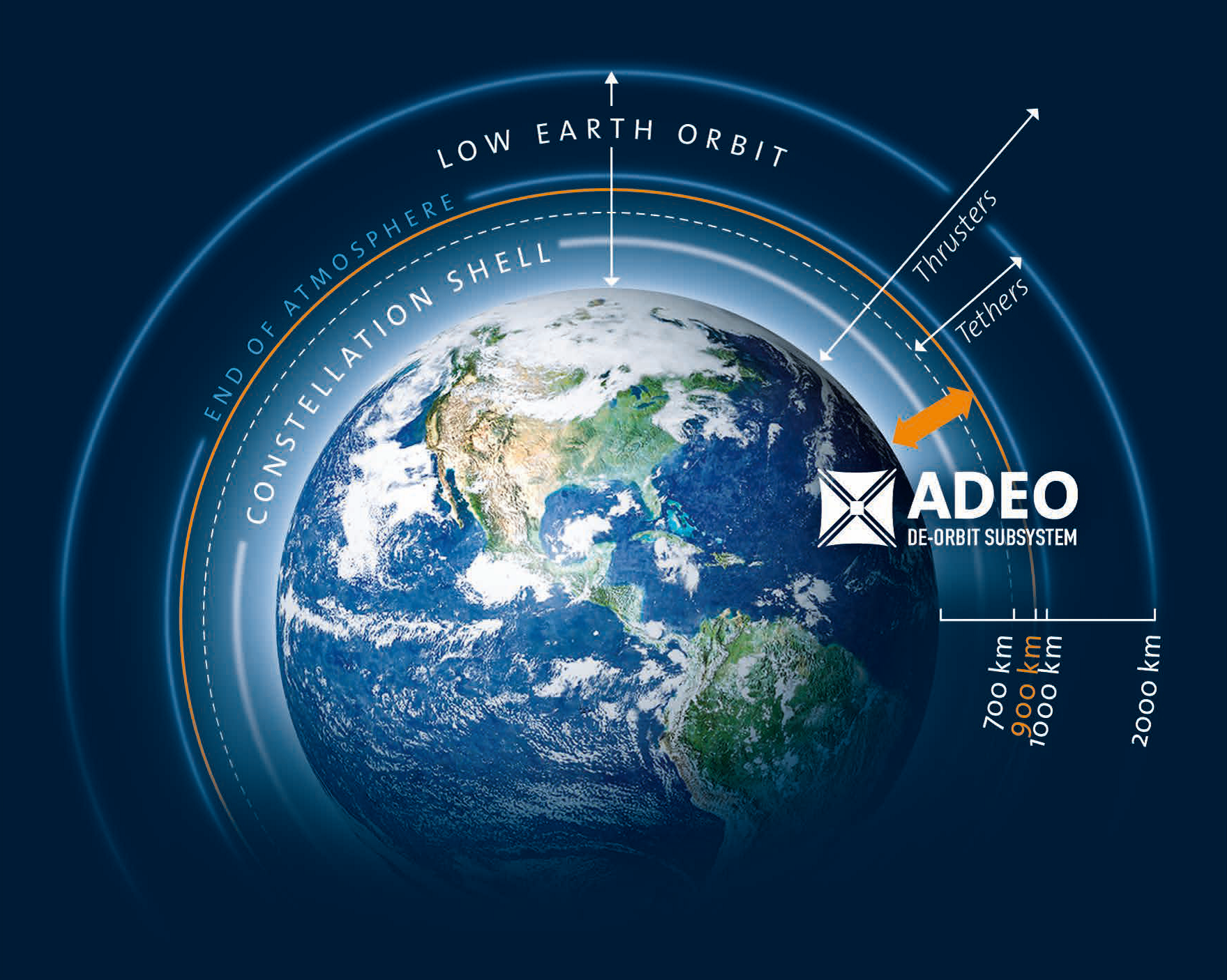
July 2022
Flight of ADEO at the end of 2022
At the height of the summer vacations, HPS in Munich is at full power for the preparations for the third mission of the innovative ADEO space braking sail, which deploys automatically at the end of the mission and propels “its” satellite up to 20 times faster to burn in the atmosphere. This avoids pollution and makes space travel sustainable.
It will arrive in Italy as early as the end of August for assembly on the ION Satellite Carrier, D-Orbit’s orbital transfer vehicle (OTV). It is the ADEO-N version for small satellites with a sail area of 5 square meters.
Falcon 9 from SpaceX will be responsible for the transport into a mid-inclination orbit towards the end of 2022. With the flight heritage accumulated by the end of the year, ADEO will enter a new space age in 2023.
At least for European missions or missions from Europe, there will most likely be no more launches without deorbit technology on board:
The EU’s Green Deal then also applies to clean-green missions in space.
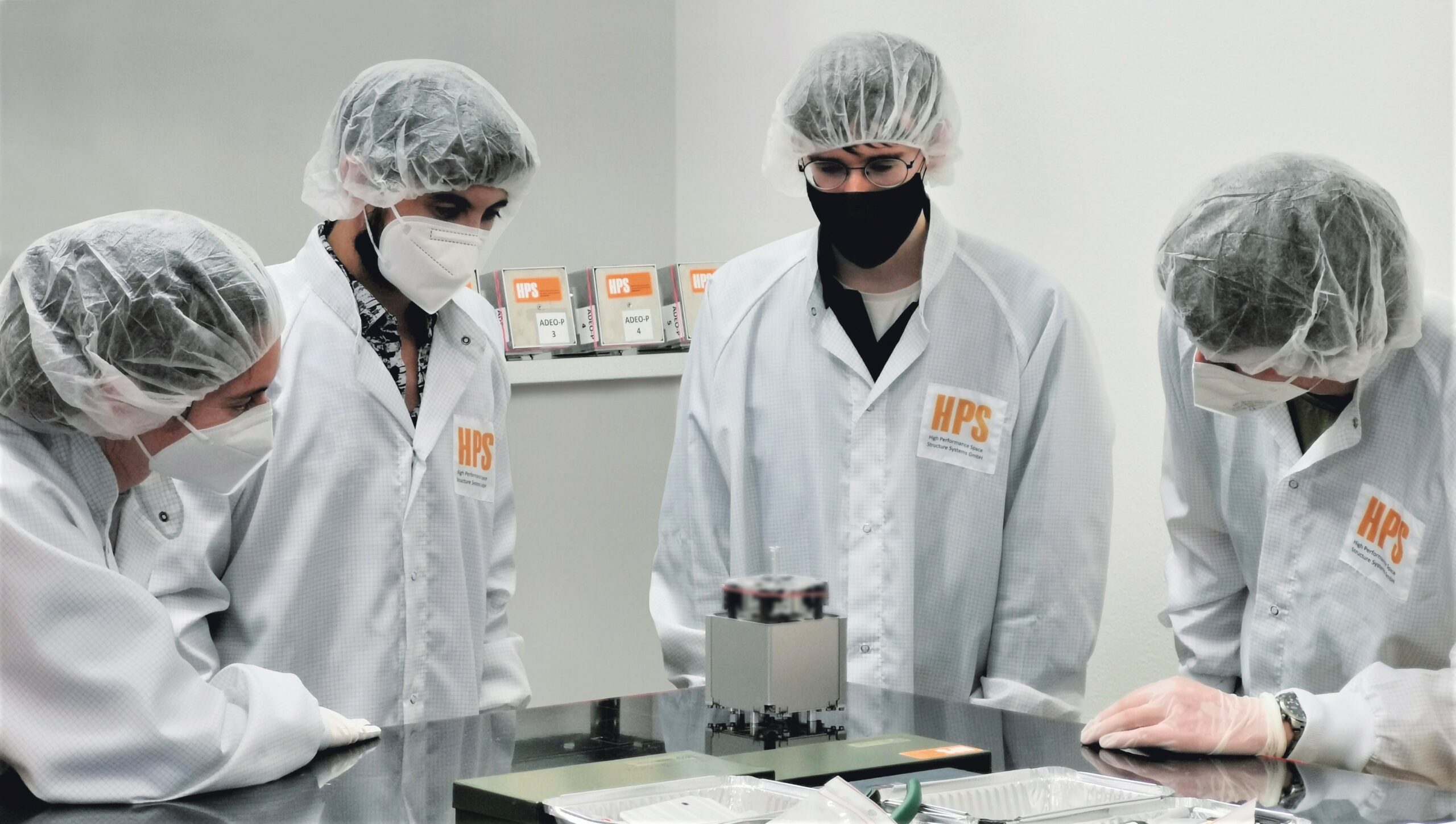
June 2022
Breaking News: ADEO dragsail by HPS as standard deorbit device for “Reflex Aerospace satellites”
Next milestone in commercializing ADEO dragsail for deorbit:
Reflex Aerospace (supplier of tailor made, high performance small satellite platforms) announces to use the automatic ADEO dragsail by HPS as standard deorbit device for their satellites. ADEO will guarantee a maximum deorbiting time of less than 5 years and contribute to Reflex Aerospace´s philosophy of responsible, sustainable and future-oriented space missions. Together we realize CleanGreen Space missions!
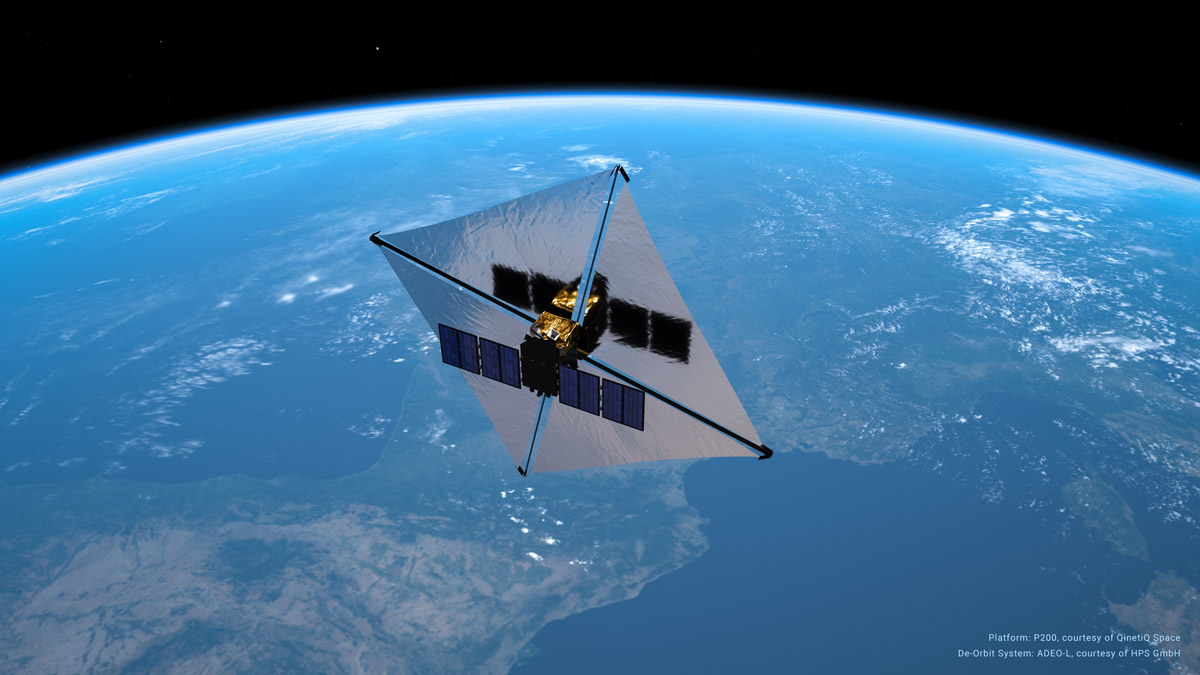
December 2021
World premiere: Deorbit-Turbosail „ADEO“ by HPS has been selected to safeguard sustainability of Europe´s own constellation
By 2025, Europe will have its own constellation of satellites to ensure sovereign capacity for both commercial and institutional communication channels. Fast Internet, autonomous mobility at sea, on ground and in the air, automatic exchange of information between technical installations, support for military and humanitarian actions, and other applications for public authorities, companies, and citizens realised by a consortium formed by Reflex, laser specialist Mynaric and launch service provider Isar Aerospace.
The European Commission is also very interested in such a concentration of innovative forces and selected the UN:IO consortium for one of its two study tenders addressed to companies from the so-called “New Space” domain and endowed with 1.4 million euros. For the EU, a secure, very fast and, above all, sovereign communications network for Europe is a top priority. In addition, it must meet sustainability criteria for the EU’s “Green Deal” – and that is where ADEO comes in: The ADEO subsystem is a scalable, deployable drag augmentation device that uses the residual Earth atmosphere present in Low Earth Orbit (LEO) to passively de-orbit satellites between 1 to 1.500 kg. For the de-orbit manoeuvre, a large surface is deployed which multiplies the drag effect of the satellite´s surface significantly: The drag force is increased causing accelerated decay in orbit altitude. Advantageous about a drag augmentation device is that it does not require any active steering and can be designed for passive attitude stabilization, thereby making it also applicable for non-operational, tumbling spacecrafts. The passive ADEO subsystem requires neither extra propulsion nor engine, which makes it lighter in comparison to active subsystems.
So, after years of development, tests and zero-g- and in-orbit-verifications ADEO is now going to celebrate its world premiere as central element bringing sustainability to space on angel wings.
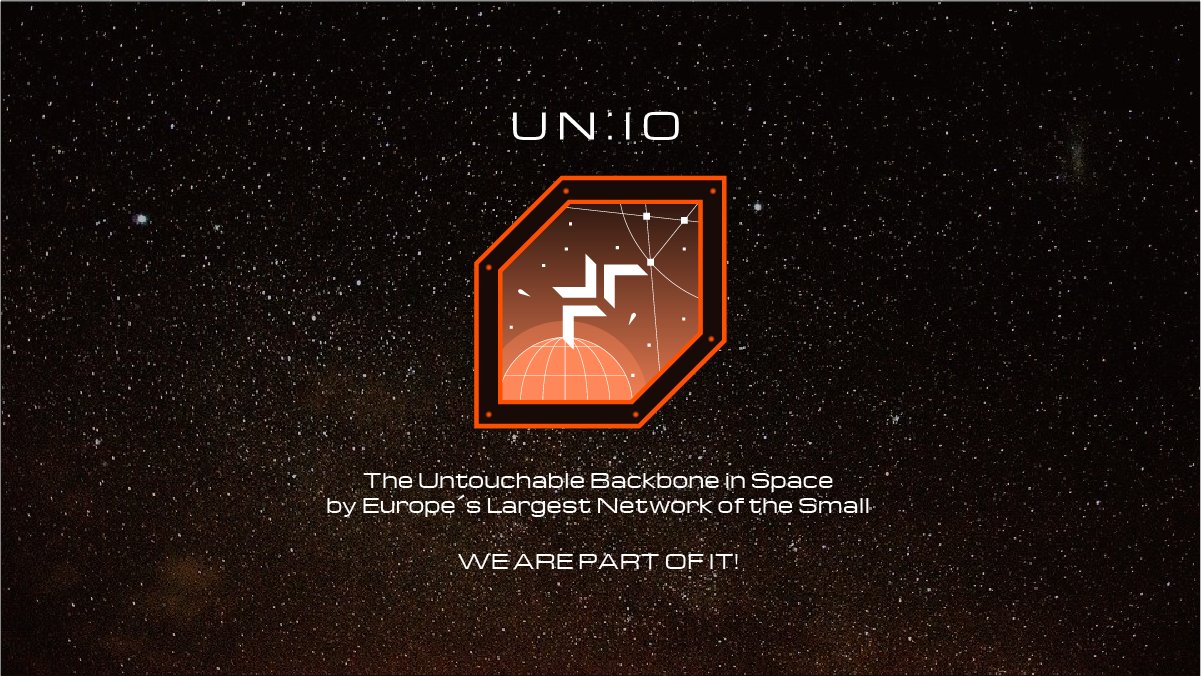
July 2021
Falcon 9 rocket successfully deploys innovative technology to keep space sustainably clean
On Wednesday, June 30, at 21.31 hrs CEST a Falcon 9 by Space X took off to a transporter 2-mission from legendary spaceport Cape Canaveral, Florida. On board: Italian NewSpace company D-Orbit´s ION Satellite Carrier on its „Wild Ride“-mission with tech-passengers from 11 countries, among that HPS’s ADEO-N2, named „Show me your Wings“. ION was successfully separated from the launcher exactly one hour after liftoff.
The ION-platform itself will now seperate one payload after the other on their respective orbits for in-orbit validation tests, until finally the platform turns into a test object itself, since it will be brought back „home“ by ADEO, the world’s only industrial NewSpace drag sail of its kind for the multiple accelerated return of retired satellites. The idea behind it: „Just keep space „cleangreen“ by launching only what you have equipped with a device to bring it quickly back home after use“, says Ernst K. Pfeiffer, CEO of German spacetech company HPS. ADEO is available from HPS in different versions tailored to the size and weight of the spacecraft in question. In this case, it is one of the smallest versions, weighing just 800 grams, with dimensions of only 10x10x10 centimeters and a sail area of 3.6 square meters.
HPS CEO Ernst K. Pfeiffer is convinced that ADEO came at exactly the right time to promote sustainable NewSpace development by avoiding the threat of apocalyptic space debris scenarios, despite rapidly growing constellations. In this context, Pfeiffer emphasizes the excellent R&D support provided by engineers and test facilities of the DLR Institute of Space Systems in Bremen, as well as the various economic development support contracts and grants provided by ESA, DLR and the Free State of Bavaria.
The implementation of the technology developed by HPS’s NewSpace Team at Munich headquarters was largely supported by the hands of engineers and technicians of the Romanian subsidiary and Romanian workshops. This is now, according to Pfeiffer, „our clear advantage having all in one company: heritage from institutional space, a tailored „internal start-up department“, a steadily growing house in Bucharest and several trustful development and production partners. New and expanded challenges to innovation and manufacturing are already waiting.“
At the end of the nominal ION-mission, in front of its “eyes” of the integrated cameras, the ADEO braking sail module unfolds, shows its „wings“ and leads ION to residue-free disposal by incineration in the atmosphere much quicker than without the sail. The first 100 km of descent will be monitored intensively. This is planned to happen in a mission slot between December ´21 and January ´22. This mission now is the last verification in a series that also encompasses a first flight on Rocket Lab´s Electron in 2018 and several parabolic flights until 2021.
With this inflight-proof of maturity ADEO is targeted to go then into serial production for customers already waiting in the U.S., Europe and Asia.
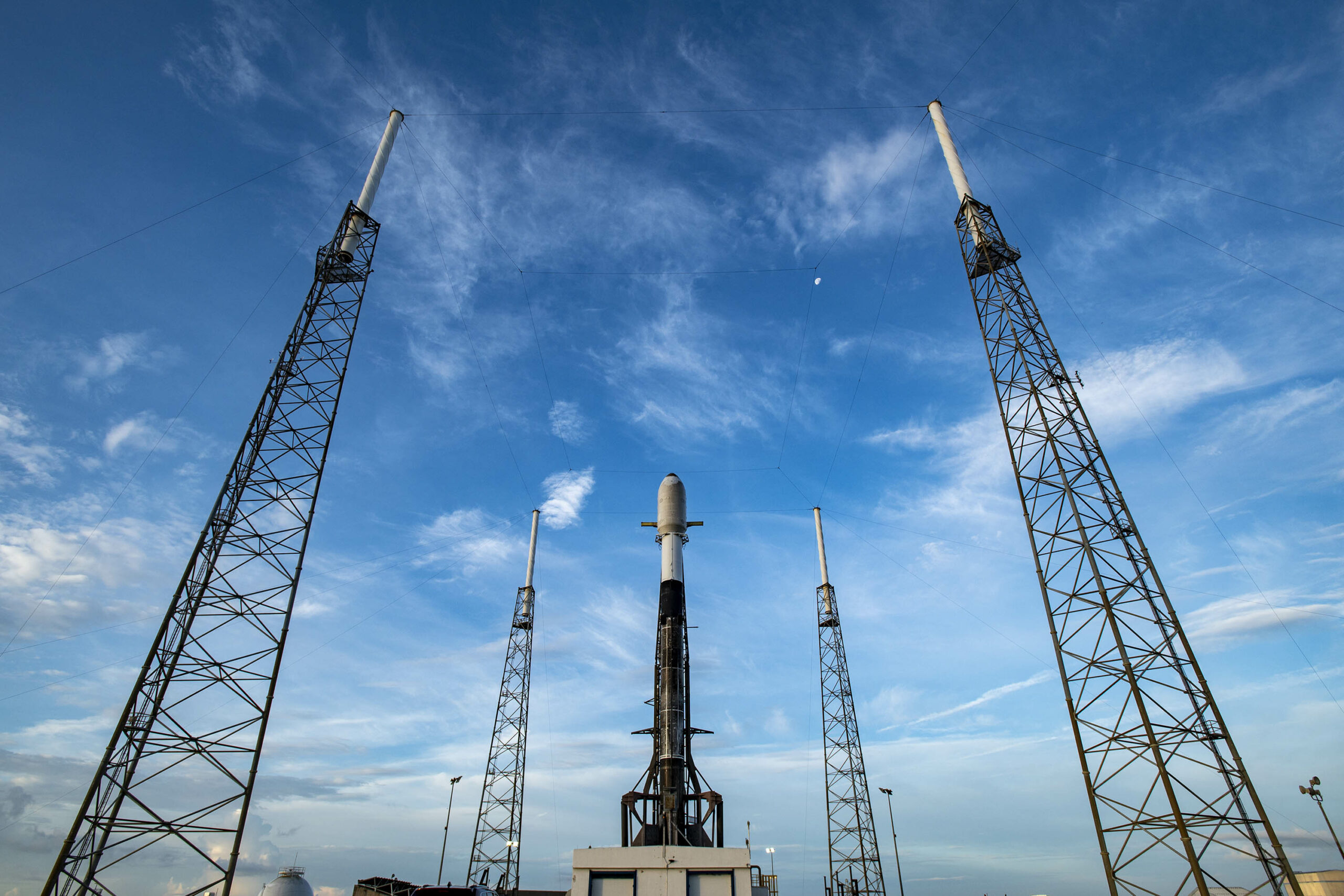
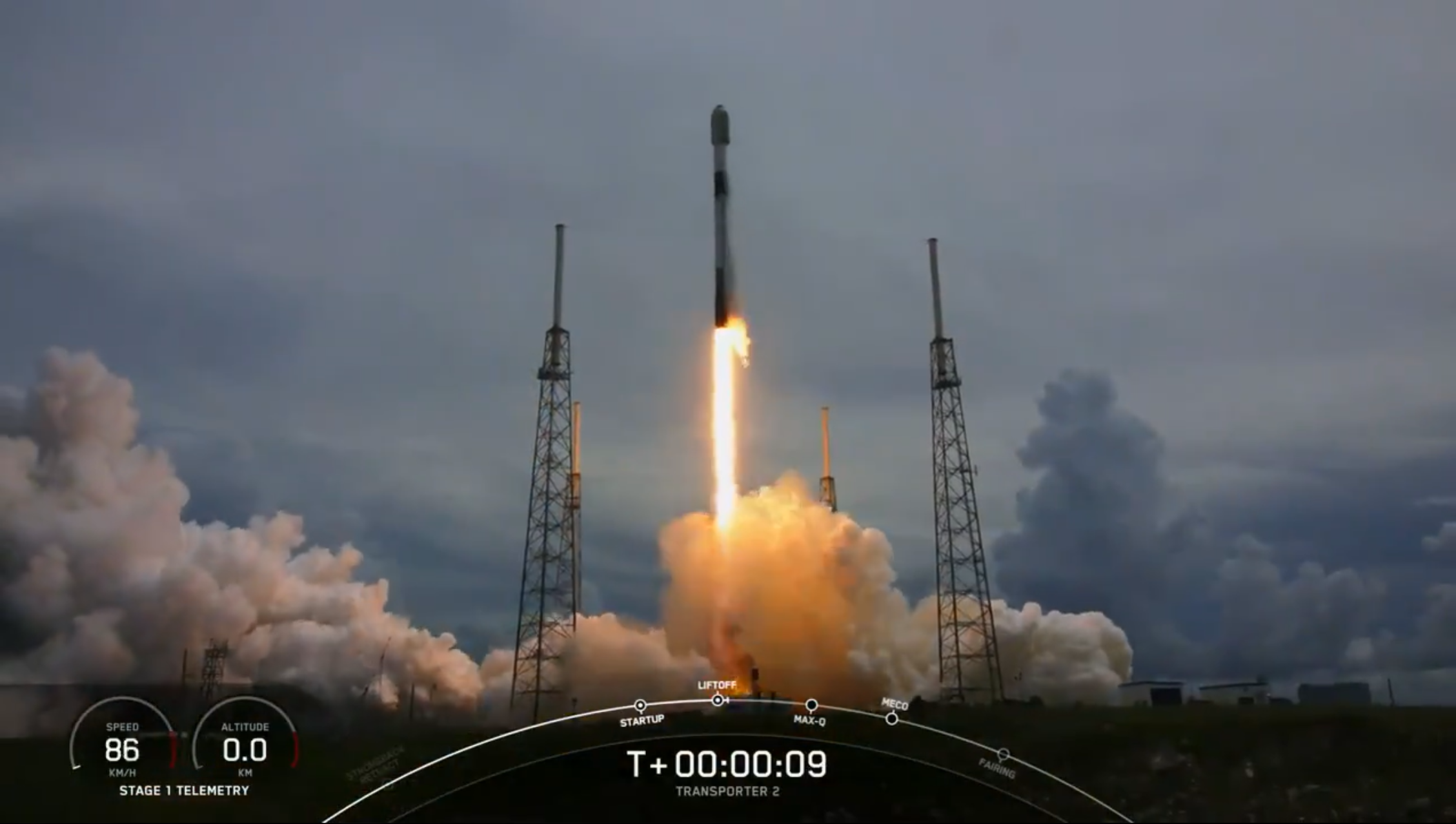
May 2021
D-Orbit (Italy) and HPS (Germany, Romania) agree on flight for
ADEO on ION Satellite Carrier in June 2021
After 6 years of development, including a zero-G parabolic campaign and a first test flight end 2018 with Rocket Lab’s ELECTRON, HPS signed on 30.04.2021 the contract with D-Orbit for the flight of the ADEO-N, named „Show me your Wings“, on the space logistics company’s orbital tranportation vehicle ION Satellite Carrier. The launch of the „Wild Ride“ Mission will take place already summer this year from a launch site in USA.
ADEO, the world’s only industrial NewSpace drag sail of its kind for the multiple accelerated return of retired satellites, is available from HPS in different versions tailored to the size and weight of the spacecraft in question. In this case, it is one of the smallest versions, weighing less than one kilogram, with dimensions of only 10x10x10 centimeters and a sail area of 3.6 square meters. It has been integrated directly into the ION platform at D-Obit now, mid May. ION is a space vehicle that can transport satellites in orbit and release them individually into distinct orbital slots. At the end of the nominal ION-mission, in front of its “eyes” of the integrated cameras, the ADEO braking sail module unfolds, shows its „wings“ and leads ION to residue-free disposal by incineration in the atmosphere much quicker than without the sail. The first 100 km of descent will be monitored intensively.
HPS CEO Ernst K. Pfeiffer is convinced that ADEO came at exactly the right time to promote sustainable NewSpace development by avoiding the threat of apocalyptic space debris scenarios, despite rapidly growing constellations. In this context, Pfeiffer emphasizes the excellent R&D support provided by engineers and test facilities of the DLR Institute of Space Systems in Bremen, as well as the various economic development support contracts and grants provided by ESA, DLR and the Free State of Bavaria.
The implementation of the technology developed by HPS’s NewSpace Team at Munich headquarters was largely supported by the hands of engineers and technicians of the Romanian subsidiary and Romanian workshops. This is now, according to Pfeiffer, our clear advantage having all in one company: heritage from institutional space, a tailored „internal start-up department“, a steadily growing house in Bucharest and several trustful development and production partners. New and expanded challenges to innovation and manufacturing are already waiting.
According to Renato Panesi, co-founder and CCO of D-Orbit: „We are very happy to have a chance to work with HPS on this project: sustainability in general has always been a relevant aspect of our identity, and with HPS we share a common vision aiming to a sustainable access to space. Being able to help HPS to test a new and innovative technology like ADEO to help control the increment of space debris is a point of pride for us. To HPS is reserved the grand finale of the mission and, while we are going to „enjoy the ride“, we are really looking forward to it“.
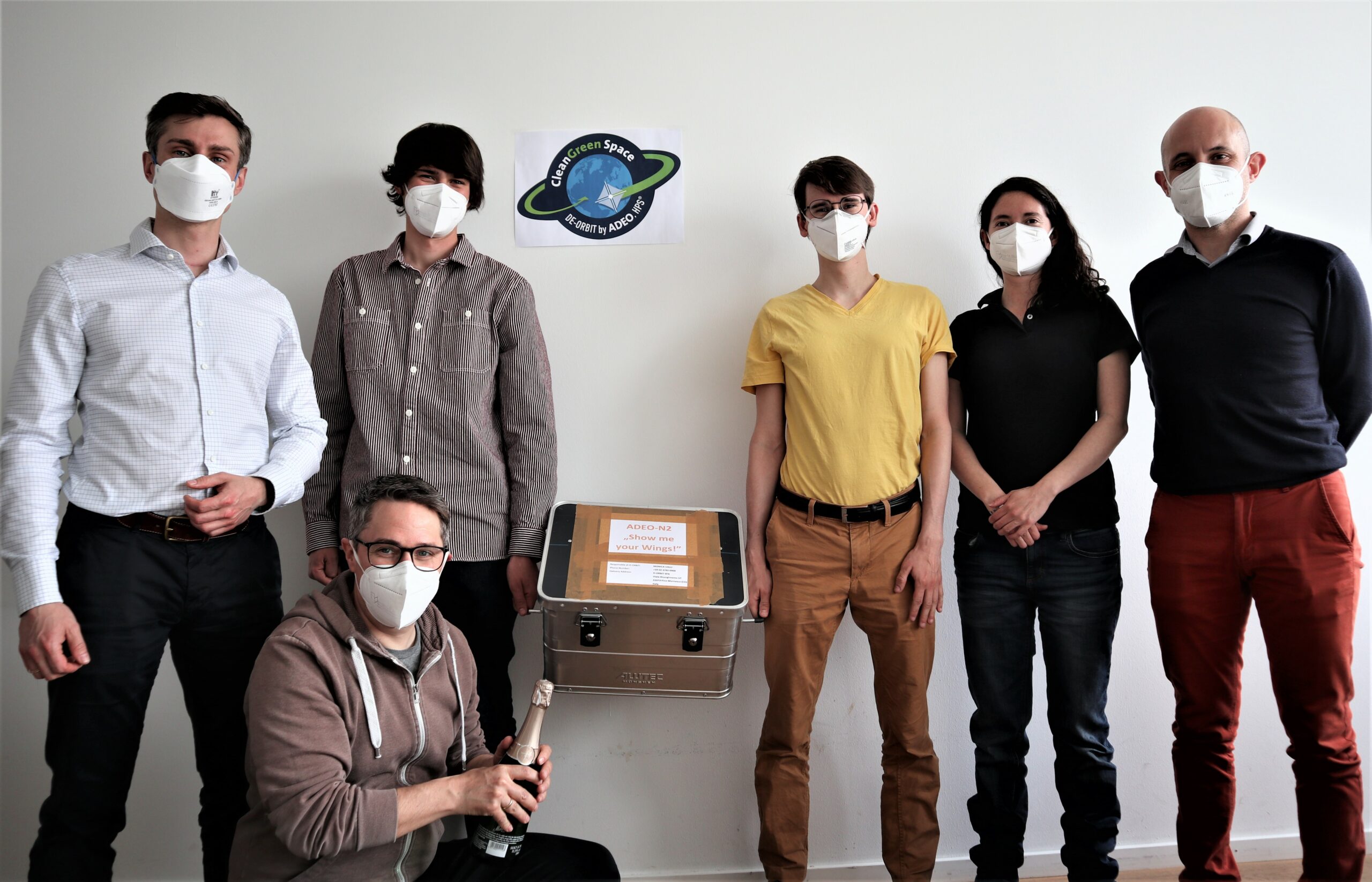
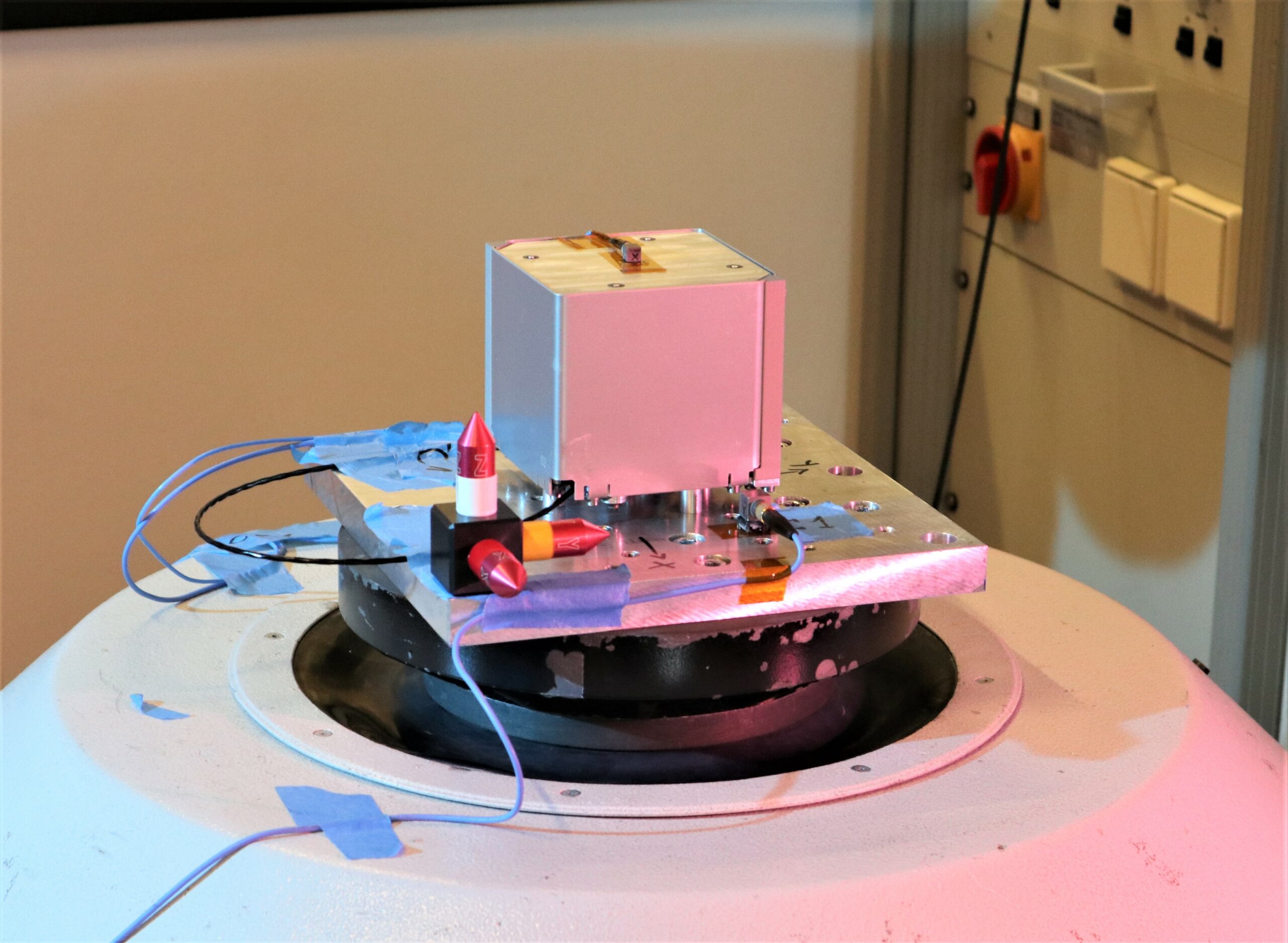
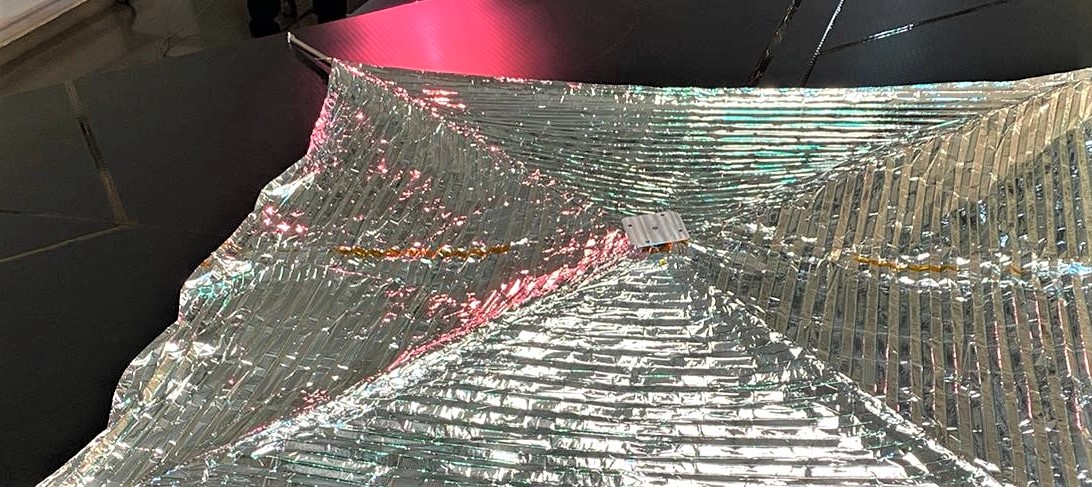
March 2016
ESA-Prime HPS with SME-Consortium Ready to Build New Generation De-Orbiting Subsystem
Hardly any messages have dominated the space community´s discussions in the past two years as perseverently as these two:
- the debris from past satellite missions forms a growing threat to future endeavors in space
- the number of satellites expected to form future constellations especially on LEO is exploding since new players are discovering space as their domain
- which again multiplies the problem of future debris.
So, on the one hand enormous growth of the satellite business is to be foreseen, on the other hand this business needs better rules in order to be sustainable. „Clean Space“ is ESA´s answer in general and the quest for a new, fully ecological de-orbiting sailsystem in particular.
While currently satellite manufacturers are already facing problems to comply with the 25-years-deorbiting „guideline“ without minimising the effectiveness and increasing the cost of their missions, ESA now aims to make this period as a strict requirement leaving neither ecological nor economical footprints.
Capitalizing on previous research and development in this area like the precursor project ADEO, led by the subsystem prime HPS with its consortium of DLR-institutes in Bremen and Braunschweig and the SMEs Etamax and HTS, ESA now announced its expectations for a full fledged demonstrator ready to fly by 2018 with a deorbiting time of lower than 5 years. The new project will be ignited this year and ESA´s subsystem prime HPS is expected to take this next step towards the final breakthrough in deorbiting technology, too, because:
- the current HPS precursor project ADEO, featuring a 5m x 5m deployable boom and sail subsystem weighing just 20kg, has been successfully tested on breadboard level in February 2016 and will reach design maturity for an Engineering Model manufacturing and assembly through a CDR in these days in March.
- ADEO will then already fulfill the requirements of providing sail and boom materials able to withstand the very severe Atomic Oxygen (AtOx) and Ultra Violet (UV) environment, offering scalability down to 100-kilo-satellites down from the current reference case of spacecrafts at 1-1.5 tons of weight, and of providing reliable deployment technology tested under ambient conditions and in a vaccum chamber in mid 2016.
HPS as ESA subsystem prime is aiming at the follow-on project also with its proven partners.
In parallel and as leading specialist on deployable structures and antennas, HPS Germany acts as prime contractor for Large Deployable Antennas (LDA) in cooperation with the German SME LSS, while the HPS subsidiary in Portugal is working on a deployable highprecision mast system (10-20m) for instruments weighing 100-250 kg on science missions.
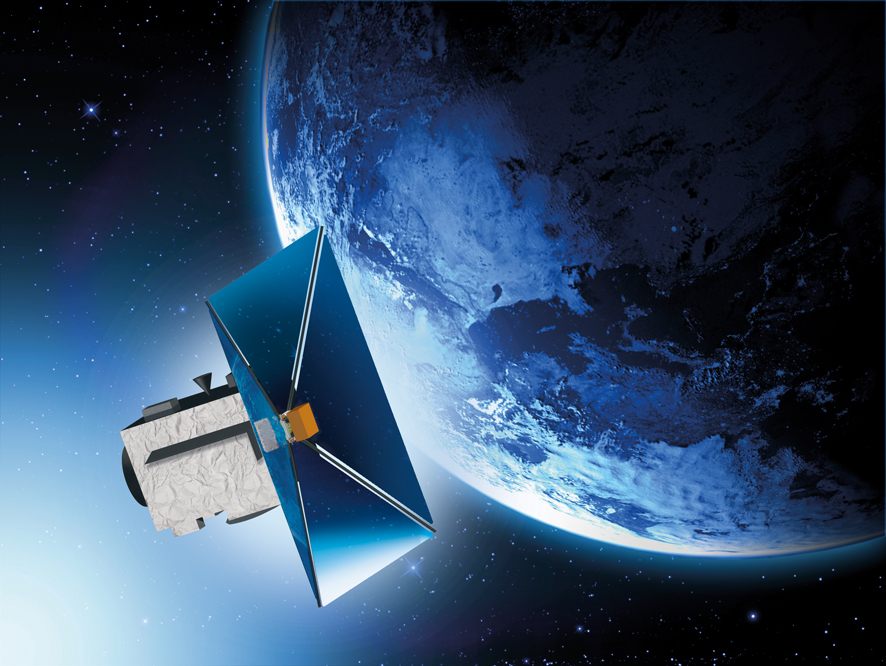
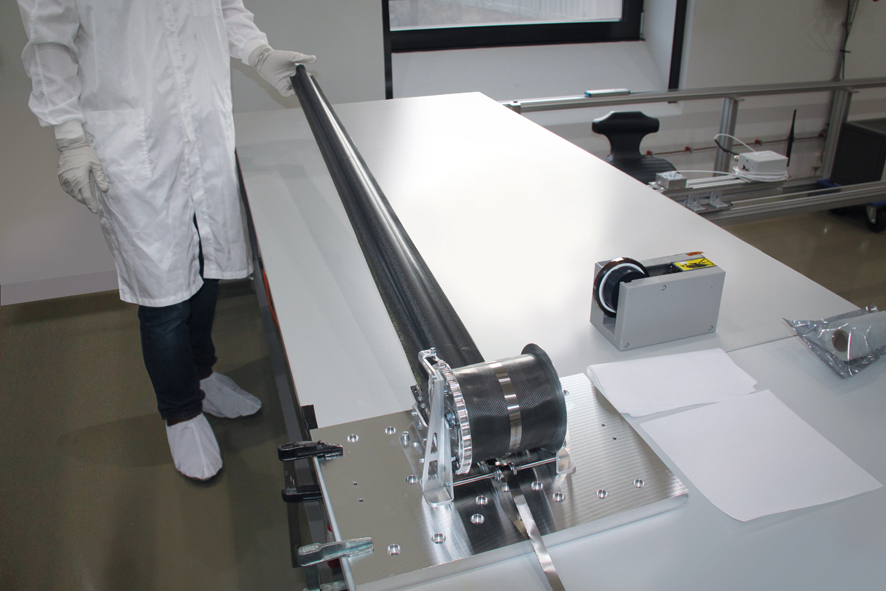
June 2016
Interview HPS-SpaceNews mit Dr. Ernst Pfeiffer, CEO von HPS und Sprecher der deutschen Raumfahrt-KMU im AKRK
Space-News:
In den letzten Wochen und Monaten haben Sie als Sprecher der deutschen Raumfahrt-KMU einen Marathon der Veranstaltungen in Vorbereitung der ESA-Ministerratskonferenz absolviert. Kam diese plötzliche Berücksichtigung der Raumfahrt-KMU durch die Institutionen für Sie überraschend?
Pfeiffer:
Keineswegs. Zum einen haben wir in den vergangenen Jahren sehr stark drauf hingearbeitet, dass unser AKRK-Zusammenschluss der rund 40 von insgesamt 90 Raumfahrt-KMU mit ca. 1500 von insgesamt 2500 Beschäftigten in Deutschland endlich als einziger unabhängiger Ansprechpartner des Mittelstandes zur Kenntnis genommen wird. Und sicher hat auch unsere kumulierte Darstellung von Kompetenz, Wirtschafts- und Innovationskraft in der kürzlich vorgestellten Website „Best-of-Space.de“ dazu beigetragen. Wir sind in der Tat auf Augenhöhe mit den Großen der Branche von ESA und deutschem Wirtschaftsministerium berücksichtigt worden. Das galt zwar schon zum High Level Forum der ESA im Juni letzten Jahres, startete aber dieses Jahr intensiv mit einem Vortrag über das Technologieprogramm vor den ESA-Delegierten am 9. Mai, ging über ein Top Level Gespräch über die ESA Strategie zwischen ca. 10 CEOs der europäischen Raumfahrtfirmen und ESA-Generaldirektor Herrn Wörner mit allen seinen Direktoratschefs am 12. Mai, weiter zur Panelveranstaltung „New Space“ am 2. Juni auf den Space Days der ILA in Berlin und schließlich zum diesjährigen High Level Forum der ESA am 20. Juni auf dem ich im Panel über „Next Steps for ESA“ eingeladen bin.
Space-News:
Alle reden von „new space“ ….
Pfeiffer:
Genau, alle reden über „new space“ – und meinen in Ermangelung eines europäischen Weges den amerikanischen, der da lautet: „machen, was finanzkräftige Quellen haben wollen“ und „mit privatem Risiko finanzieren, und wenn es schief geht werde ich auch nicht arm woran man selber glaubt“
„Masse über Klasse stellen und dabei Qualitätsverluste in Kauf nehmen, solange sie sich zumindest kurzfristig rechnen“.
Space-News:
Ist das auch der europäische Weg?
Pfeiffer:
Niemand in Europa wird das unterschreiben. Zum einen, weil es diese finanzkräftigen Unternehmen in D und EU nicht gibt, ebenso wenig wie die Risikofinanzierer und schon gar nicht die Mentalität, nicht nachhaltiges Billiges zu bauen, dabei Qualität zu opfern und Folgekosten (Schrott etc) für kommende Generationen ohne Ansicht der Dimension in Kauf zu nehmen.
Abgesehen davon, ist es ein gewaltiges Risiko, sich darauf zu verlassen, dass schon genügend reiche Unternehmen aus den USA auf Ideen kommen, wie sie denn durchgehend die Raumfahrtindustrie in Europa beschäftigt halten können.
Space-News:
New Space in diesem amerikanischen Sinne ist also weder europäisch, noch ist es geeignet, gerade KMU eine Perspektive zu geben?
Pfeiffer:
New Space europäischer Machart wäre das Ergebnis auch europäischen Vorgehens und Denkens. Und da haben wir eine Menge aufzuweisen. Wir machen nicht einfach mal eben so etwas, weil es vielleicht hier oder da kurzfristig Gewinn bringt – wir machen überhaupt nichts nur nach dem reinen Prinzip kurzfristigen ökonomischen Gewinns. Wir machen die Dinge in Europa so wie wir sie machen, weil für uns hier die Dinge immer einen viel tieferen Sinn und Nachhaltigkeit, als kurzfristig in Dollar messbar ergeben müssen. Ziel in Europa war es bisher, nicht nur eine Handvoll reicher Unternehmen noch reicher zu machen, sondern möglichst viele Unternehmen nachhaltig und langfristig zum Wohle einer unabhängigen, ausgeglichenen Gesellschaft zu erhalten. Derzeit besteht
Gefahr, dass dieses Gleichgewicht und die Unabhängigkeit in Europa kippt.
Space-News:
Wie drückt sich das aus?
Pfeiffer:
Lassen Sie mich ein Bild bemühen. Nach eben beschriebener amerikanischer Mentalität soll ein Produkt hinreichend funktionieren, nur Schäden für den unmittelbaren Nutzer müssen ausgeschlossen bleiben. Auch wir können uns sicher nicht alle der Faszination eines mächtigen V8 und dem Reiz vergleichsweise unendlichen Sitz- und Reisekomforts eines typischen US-Autos entziehen. Im Gegensatz zum Amerikaner nehmen wir es dann aber schon übel, wenn zugunsten eines schnelleren Verkauf garantierenden Preises dann unterwegs mal ein Knopf hier abfällt oder ein Schalter da nicht funktioniert. Und erst recht unakzeptabel ist für uns die Vorstellung von ressourcenvernichtenden Trinksitten und materialverschwendendem Design, was alles dann nur nachfolgenden Generationen Probleme macht. In Europa denken wir anders; Nachhaltigkeit hat für uns zwingend etwas mit Qualität zu tun. Darin sind wir gut, und darin sind wir besser als alle anderen – USA, Asien, Russland.
Space-News:
Was folgt daraus für „new space“ made in Europe?
Pfeiffer:
Wenn das so ist, sollten wir das auch zur Grundlage unseres „European way of new space“ machen. Nicht warten, bis irgendwer von irgendwo irgendeinen kommerziellen Auftrag platziert, sondern die Landschaft solcher Aufträge samt Staat, Auftraggebern, Programmen und Auftragnehmern selbst vorzeichnen.
Wenn wir als KMU politik- und öffentlichkeitswirksam dieses Feld der systematischen Suche nach vernünftigen, nachhaltigen und politisch wie wirtschaftlich höchst wünschenswerten „new space – Projekten made in Europe“ besetzen, besetzen wir damit gleich das ganze Feld „new space“ selbst und jegliche Diskussion darum. Wir stellen solide Weichen, statt blind Trittbrett zu fahren!
Space-News:
Kann das wirklich in Anbetracht der „unendlichen Möglichkeiten“ jenseits des Atlantiks funktionieren?
Pfeiffer:
Sicher kann es das, und ich bin darüber hinaus sicher, dass es seine Wirkung auf den „American way of new space“ auch nicht verfehlen wird. Nehmen Sie wieder das Bild vom Auto. Wie kommt es wohl, dass amerikanische wie auch japanische Hersteller in den letzten rund zwanzig Jahren vermehrt dazu übergehen, europäisches Design, und europäische Technik und Europäisches Umweltbewußtsein als Maßstab mitzunutzen? Das Bessere ist des Guten Feind, das wird auch bei „new space“ auf lange Sicht nicht anders sein.
Space-News:
Ist das Ihre Hauptbotschaft auf dem Marathon zur Ministerratskonferenz?
Pfeiffer:
Das und der dringende Hinweis, dass wir beim Hype um „new space“ unseren „old space“ nicht vergessen sollten, sprich: weiterhin Investition in Höchst-Technologie. Gerade wir Deutschen sind ja oftmals so eifrig dabei, neue Dinge – besonders, wenn sie aus den USA kommen – über das Bestehende zu stellen. Davor kann ich nur warnen. Bei aller Begeisterung für Neues – die liegt ja auch irgendwo in der menschlichen Natur – das zu vernachlässigen, was uns in der Raumfahrt groß gemacht hat, endet für uns im Desaster, in einer verlorenen Unabhängigkeit Deutschlands. Um abschließend noch mal den Autofahrer-Blick einzunehmen: Wenn wir mit unausgegorener Taktik, mangelnder Schnelligkeit und unzureichender (Finanz-) Kraft auf die linke Spur wechseln, um einer Chimäre nachzujagen, müssen wir uns nicht wundern, wenn uns traditionelle, staatsgetriebene Old-Space-Länder Europas und Asiens auf der Pannenspur technologisch überholen. Als Raumfahrt-KMU werden wir jedenfalls schön weiter hochinnovativ die technologische Mitte besetzen und von dort aus versuchen, flexibel mit neuen, kreativen Ideen von Anwender-KMU den „European Way of New Space“ zu leben.
Eine zweite Botschaft an die Ministerratskonferenz wäre noch: Nutzt die aktuelle Begeisterung für Raumfahrt in der Gesellschaft für Inspiration, europäischen Zusammenhalt, globale Zusammenarbeit und damit Friedenssicherung.
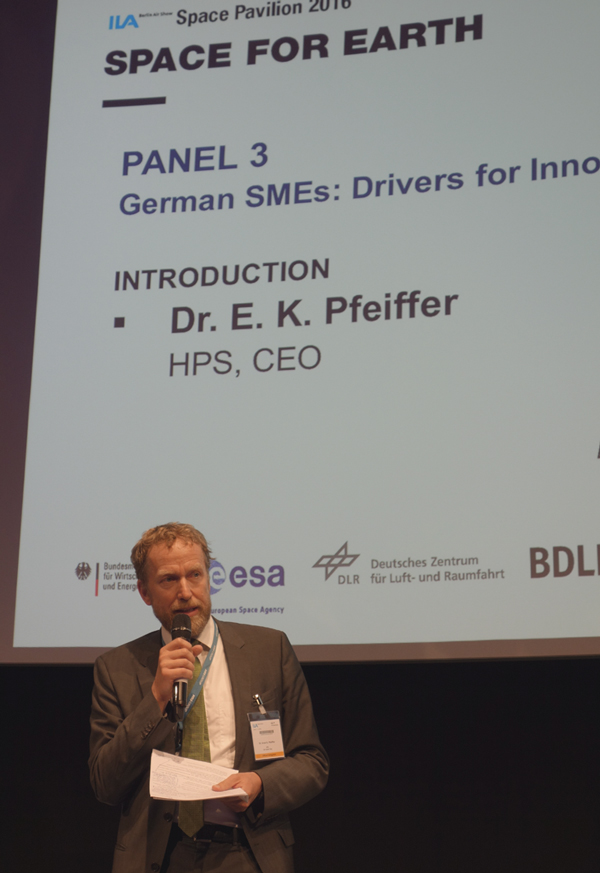
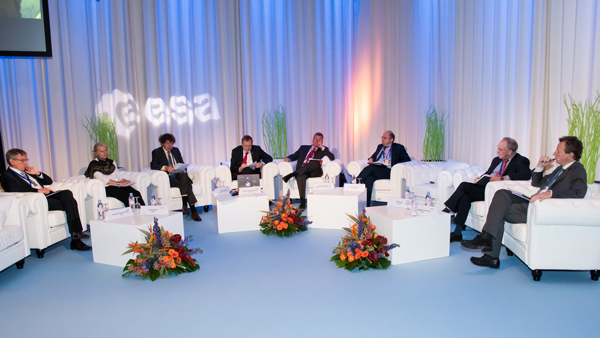
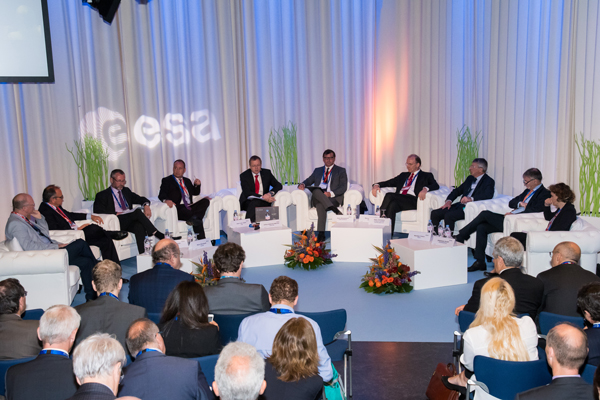
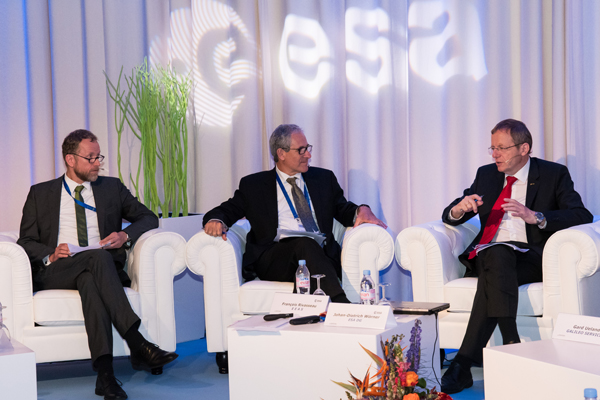
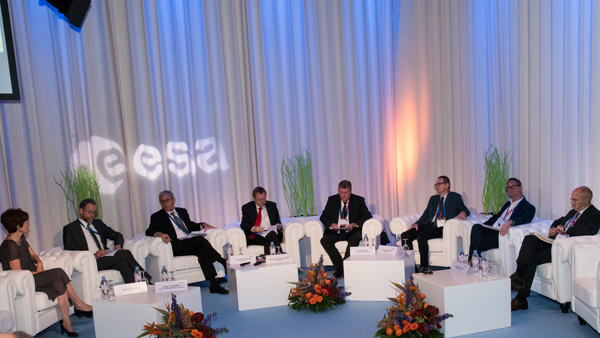
June 2018
Just a few weeks before the launch of „Pride of Bavaria“, the space test mission of the nano-version of the space sail system ADEO for fast deorbit of decommissioned satellites, Bavarian minister of economy Franz-Josef Pschierer paid a personal visit to HPS, the Munich based driver of spacetech innovations. Founder and CEO of HPS, Dr. Ernst K. Pfeiffer, explained the ADEO-system designed to avoid space debris – a unique development which has been funded by Bavaria – and also introduced other important product lines to the minister: reflectors for antennas serving earth observation and telecommunications projects in space, which today are the European benchmark in high frequency data transmission, thermal and radiation protection systems, large deployable antennas, and a high-precision mesh-net for the reflection of antenna signals – developed by HPS and produced in Hof, center of the Bavarian industrial „textil triangle“. (Links to tv-coverage/interviews: https://www.sat1.de/regional/bayern/videos/die-sendung-vom-25-05-2018-ganze-folge)
On Saturday, May 26th, the HPS-crew took the ADEO flight model plus a spare to the launch site in New Zealand. ADEO will be launched end of June aboard an American ELECTRON rocket of RocketLab (lLinks: http://spacenews.com/rocket-lab-reschedules-next-electron-launch/; https://www.rocketlabusa.com/)
